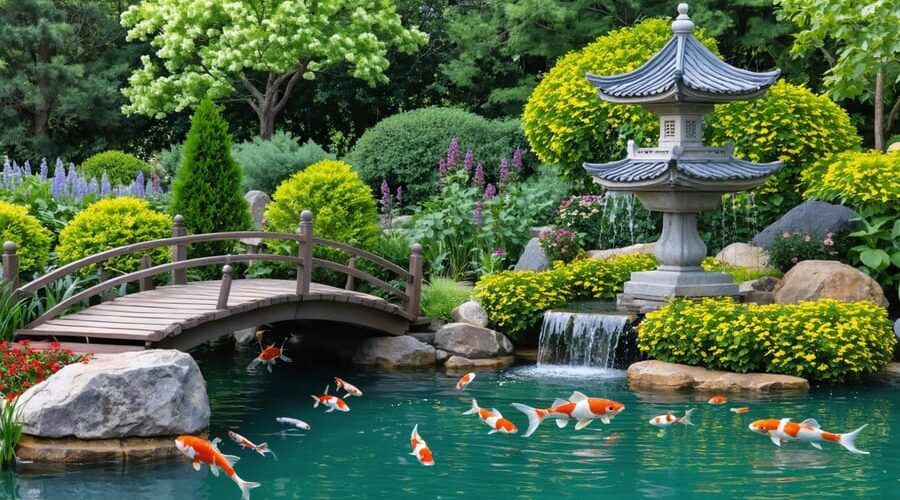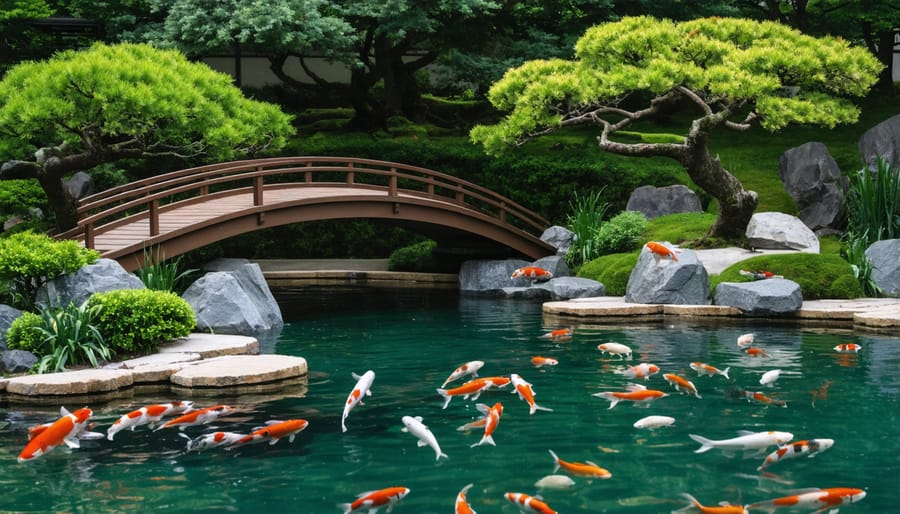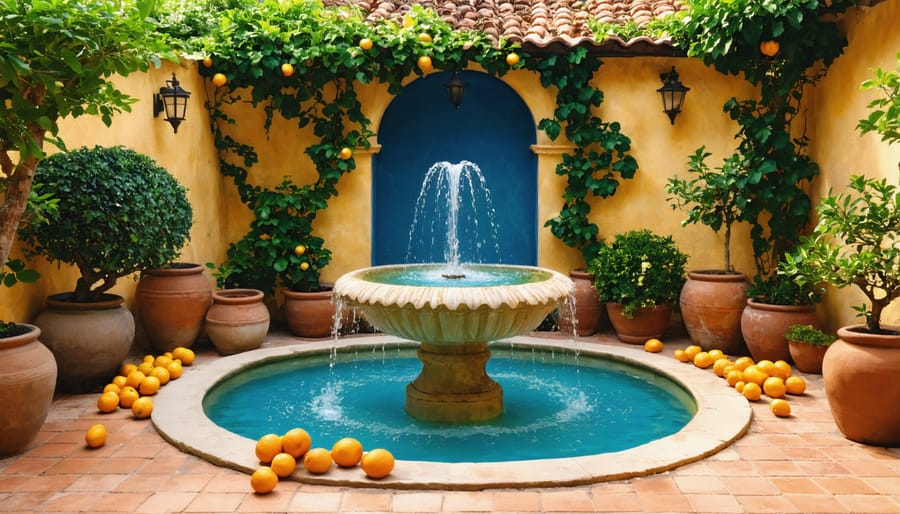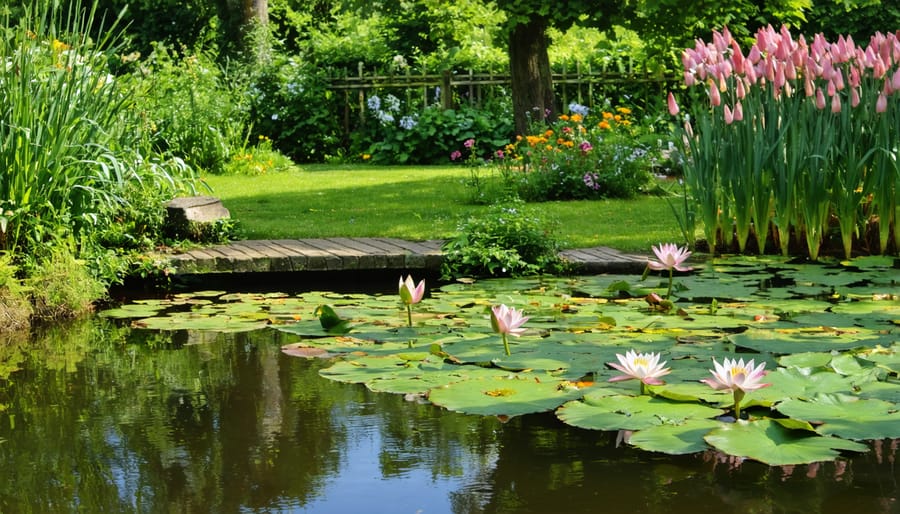
Transform Your Backyard with These Stunning Cultural Pond Designs
Transform your backyard into a living masterpiece by crafting a pond that reflects both cultural heritage and personal style. Drawing inspiration from centuries-old natural pond design elements, today’s pond creators blend traditional wisdom with modern techniques to create sustainable water features that captivate and inspire. Whether you’re drawn to the zen-like simplicity of Japanese koi ponds, the romantic charm of English cottage water gardens, or the bold symmetry of Mediterranean fountains, designing your perfect pond starts with understanding these time-tested principles. From selecting the ideal location to incorporating indigenous materials, this guide will walk you through the essential steps to create a pond that not only enhances your outdoor space but also tells a story that resonates with your cultural values and environmental consciousness.
Japanese-Inspired Tranquility
Zen Elements and Symbolism
In Japanese pond design, every element carries deep symbolic meaning, creating a harmonious space that embodies tranquility and balance. Koi fish, considered living jewels, represent perseverance and good fortune. Their graceful movements through the water add dynamic energy while their vibrant colors create visual contrast against dark water.
Rock placement follows the principle of asymmetrical balance, with each stone carefully positioned to mimic natural formations. Large stones represent mountains or islands, while smaller ones symbolize the earth’s connection to water. Groups of three rocks are particularly significant, representing heaven, earth, and humanity in perfect harmony.
Water itself symbolizes the flow of life, with its gentle movement creating both sound and reflection. Strategic placement of waterfalls or cascades represents the journey of life, while still areas of the pond reflect the sky, creating a mirror-like surface that connects earth and heaven.
Plants play essential roles too. Lotus flowers represent enlightenment and purity, rising from muddy waters to bloom in pristine beauty. Bamboo around the pond’s edges symbolizes strength and flexibility, while moss-covered rocks suggest age and permanence.
When incorporating these elements, remember that simplicity is key. The goal is to create a space that feels natural and uncontrived, where each element has purpose and meaning.

Essential Plants and Features
A Japanese-inspired pond isn’t complete without carefully selected plants and architectural features. Water lilies are essential, providing both beauty and shade for fish. Choose varieties like the classic white Nymphaea ‘Perry’s Double White’ or the pink ‘Charles de Meurville’ for authentic appeal. Lotus plants, with their dramatic leaves and stunning flowers, add vertical interest and cultural significance.
Around the pond’s edge, incorporate Japanese iris (Iris ensata) and sweet flag (Acorus) for their elegant, sword-like foliage. Dwarf bamboo creates gentle rustling sounds and provides year-round greenery, while Japanese forest grass adds flowing texture to shaded areas.
Key architectural elements include traditional stone lanterns (tōrō), which provide soft illumination and serve as focal points. Natural stepping stones create pathways that encourage mindful walking and viewing from different angles. A wooden bridge, even a small one, adds authentic charm and practical access across the water.
Consider adding a bamboo water feature (shishi-odoshi) or a stone basin (tsukubai) near the pond. These elements contribute both visual interest and peaceful sounds. Remember to maintain good sight lines while arranging these features – in Japanese design, each element should work in harmony with the others while maintaining a sense of balance and tranquility.
Mediterranean Oasis Design
Water Features and Fountains
Mediterranean fountains add a timeless elegance to any pond design, bringing the charm of European courtyards to your backyard. Traditional designs often feature multiple tiers with water cascading from one level to the next, creating a soothing symphony of flowing water. The classic tiered fountain, made from natural stone or cast concrete, remains a popular choice for its grand appearance and reliable performance.
Water movement in Mediterranean-style features typically follows a gentle, predictable pattern. Upper bowls spill into wider basins below, creating pleasant splashing sounds that mask ambient noise. Many designs incorporate decorative spouts shaped like lion heads, shells, or classical figures – all hallmarks of Mediterranean architecture.
For authentic Mediterranean styling, consider incorporating mosaic tiles around the fountain base or adding ceramic accents in blues and terracotta tones. Small copper or bronze water spouts can provide additional visual interest while maintaining historical accuracy. The key is to balance water flow – too forceful, and you’ll lose the peaceful atmosphere; too gentle, and you might encounter stagnation issues.
Position your fountain where it can serve as a focal point, perhaps centered in your pond or as part of a larger water feature arrangement. Remember that traditional Mediterranean designs often place fountains in sheltered areas, protecting them from strong winds while maximizing their acoustic benefits.

Plant Selection and Hardscaping
When designing a Mediterranean-inspired pond, selecting the right plants and materials is crucial for creating that sun-soaked, relaxed atmosphere. Consider drought-resistant plants like lavender, rosemary, and ornamental grasses that thrive in Mediterranean climates and provide beautiful texture around your pond’s edges. Water-loving plants such as papyrus and water iris add authentic touches while helping maintain water quality.
For hardscaping elements, focus on using local materials like natural stone, terracotta pots, and weathered ceramics. Light-colored limestone or sandstone creates that classic Mediterranean look while helping reflect heat. Consider incorporating rustic elements like clay urns or stone columns as water features.
Position your plants in groups rather than single specimens, creating a more natural, flowing appearance. Mix heights and textures, with taller plants like cypress trees providing backdrop structure, while spreading groundcovers like creeping thyme soften edges. Remember to leave some open areas around the pond for seating and entertaining – after all, Mediterranean style is all about outdoor living and enjoying your water feature from different vantage points.

English Cottage Pond Style
Wildlife-Friendly Features
Creating a wildlife-friendly pond brings your garden to life with fascinating creatures and natural beauty. Start by incorporating gently sloping sides, which allow animals like hedgehogs and birds to safely access the water and escape if needed. Include a variety of planting depths to support different aquatic plants and create diverse habitats.
Add partially submerged logs or rocks around the edges to provide basking spots for frogs and newts, while also creating shelter for smaller pond inhabitants. Native aquatic plants are particularly valuable, offering natural cover and breeding grounds for insects and amphibians. Consider including floating plants like water lilies, which provide shade and protection for fish.
Create shallow, marshy areas around the pond’s edge using marginal plants. These zones attract dragonflies, damselflies, and various beneficial insects. Leave some longer grass or wildflowers near the pond to provide cover for wildlife moving between water and land.
For year-round wildlife support, maintain some open water during winter by floating a ball on the surface to prevent complete freezing. Avoid using chemicals in your pond, as these can harm wildlife. Instead, focus on achieving natural balance through proper plant selection and minimal intervention, allowing nature to establish its own ecosystem.
Traditional English Planting Schemes
Traditional English pond designs embrace a natural, cottage-garden aesthetic that’s been cherished for centuries. At the heart of this style are native marginal plants like Purple Loosestrife, Yellow Flag Iris, and Marsh Marigolds, which create a soft, flowing border around the pond’s edge. These plants are typically arranged in informal groups, mimicking how they might grow in the wild.
The planting scheme usually follows a graduated approach, with shorter plants like Water Forget-me-nots and Brooklime at the water’s edge, followed by taller specimens like Flowering Rush and Water Mint further back. Floating plants such as native Water Lilies add classic charm while helping to maintain water quality and providing shade for fish.
For authentic English charm, incorporate clusters of moisture-loving perennials like Hostas, Astilbe, and Lady’s Mantle in the surrounding borders. These create a seamless transition between the pond and the wider garden. Grasses like Sedge and Sweet Flag add movement and texture, while providing valuable cover for wildlife.
The key to success is avoiding rigid planting patterns – nature rarely grows in straight lines! Allow plants to self-seed and spread naturally, creating that coveted English cottage garden look that appears effortlessly beautiful yet carefully planned.
Modern Cultural Fusion
Mixing Design Elements
Creating a harmonious blend of different cultural elements in your pond design can transform your outdoor space into a unique sanctuary that tells your personal story. The key to successful fusion lies in understanding how different design elements complement each other while maintaining authenticity and balance. When approaching artistic pond design, think of it as creating a symphony where each element plays its part without overwhelming the others.
Start by selecting a primary cultural influence that resonates with you, whether it’s the zen-like simplicity of Japanese gardens or the bold drama of Mediterranean water features. This will serve as your foundation. Then, carefully introduce complementary elements from other styles. For instance, you might combine the clean lines of modern design with traditional Chinese elements like moon gates or distinctive rock arrangements.
Consider these practical tips for successful fusion:
– Use a consistent color palette to tie different elements together
– Maintain proportional balance between features
– Create smooth transitions between different cultural elements
– Choose plants that complement multiple styles
– Keep hardscaping materials consistent throughout
Remember that less is often more when mixing cultural influences. Instead of including every element you love, select key features that work together harmoniously. For example, pair Japanese maple trees with Mediterranean terra cotta pots, or combine English cottage-style plantings with Asian-inspired stone lanterns.
The goal isn’t to recreate exact replicas of different cultural gardens but to thoughtfully blend elements that speak to you while creating a cohesive space. This personalized approach ensures your pond becomes a unique reflection of your style while honoring the cultural traditions that inspired it.
Maintaining Cultural Authenticity
When incorporating cultural elements into your pond design, it’s essential to approach the process with respect and understanding. Research is your best friend here – take time to learn about the cultural significance of different design elements before including them in your project. For instance, if you’re drawn to Japanese garden elements, understand that each component, from stone placement to plant selection, carries deep symbolic meaning.
Consider consulting with cultural experts or members of the community whose design elements you wish to incorporate. They can provide valuable insights and help you avoid unintentional misrepresentation. Remember, the goal is to honor these traditions, not to create a theme-park version of them.
Be mindful of religious or spiritual symbols. Some elements commonly found in traditional pond designs may have sacred meanings. For example, certain statues or figurines in Chinese gardens represent specific deities or cultural beliefs. If you’re unsure about the appropriateness of an element, it’s better to err on the side of caution.
Focus on authentic materials and techniques when possible. While modern alternatives might be more convenient, using traditional materials can help maintain the integrity of the design. However, don’t feel pressured to replicate everything exactly – it’s okay to create a respectful interpretation that works for your space and budget.
Document your inspiration sources and be transparent about your design choices. If visitors ask about your pond’s cultural elements, you can explain your inspiration and demonstrate your commitment to respectful cultural appreciation. This approach helps create meaningful conversations and deeper understanding of different cultural traditions in garden design.
Remember that cultural authenticity doesn’t mean your pond can’t be unique. The key is finding the right balance between honoring traditional elements and creating a space that reflects your personal style.
As we’ve explored throughout this guide, incorporating cultural elements into your pond design can transform an ordinary water feature into a meaningful and captivating centerpiece for your outdoor space. Whether you’re drawn to the zen-like tranquility of Japanese gardens, the romantic charm of European water features, or the bold symmetry of Persian designs, there’s a world of inspiration waiting to influence your pond project.
Remember that successful cultural integration doesn’t mean strictly adhering to traditional rules. Instead, focus on the elements that resonate with you while respecting the core principles that make each style unique. Consider how features like rock placement, plant selection, and water movement can work together to create your desired atmosphere.
Don’t be afraid to blend different cultural influences or adapt them to your local environment and personal preferences. Your pond should reflect both the cultural elements you admire and your own unique vision. Start with a solid foundation of proper construction and maintenance, then layer in your chosen cultural elements gradually.
As you begin your pond design journey, take time to research and understand the meaning behind different cultural elements. This knowledge will not only help you create a more authentic design but also add depth and purpose to your water feature. Whether you’re creating a meditation space, a wildlife haven, or a social gathering spot, let cultural inspiration guide you toward creating a pond that tells your story while honoring the rich traditions that inspired it.
